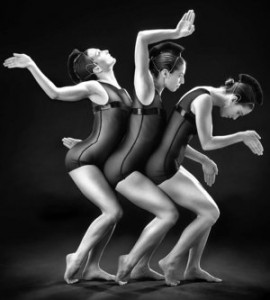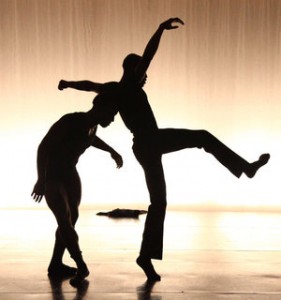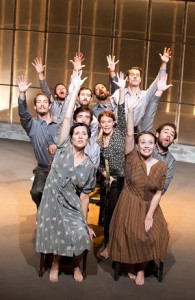Montreal dance troupe lops off prelude, filmic imagery, cool costumes.
By Merilyn Jackson
For The Inquirer
 Courtesy Marie Chouinard
Courtesy Marie Chouinard
Sandrine Lafond (left), Carla Maruca, Isabelle Poirier of Compagnie Marie Chouinard in “24 Preludes” by Chopin. The troupe began its first visit to Philadelphia in 17 years Thursday night.
At opening night of Montreal’s Compagnie Marie Chouinard at Annenberg Center, their first Philadelphia appearance in 17 years, some in the audience said they were in shock and awe after her Rite of Spring.
But after seeing Chouinard’s Rite in Phoenix in 1996 and longing to see it again all these years, I was just in shock. It was so unlike the original, my favorite of many Rites I’ve seen around the world. Company agent Paul Tanguay said Shanghai audiences will see the original with the white and tan colored leotards and Rober Racine’s 12- minute prelude, Sound Signatures. But we get a bargain-basement version, without the Racine and the costumes.
In 24 Preludes by Chopin, which opened the program, the women wore sheer black leotards taped thong-like around the groin and across the nipples, much like a costume I saw on a pole dancer at Delilah’s when I was a judge in an exotic dancer of the year contest. For both topless genders in this Rite, Chouinard recycled the same briefs as worn by the men in 24 Preludes making for a confusing opening moment. Was this merely a continuation of the first piece?
The brilliant original use of Racine’s amplified pencil on paper score had evoked pre-human insectile life, repeated visually by the angular, torso-undulating choreography. Here, Dance Celebration’s program notes say his score would extend Stravinsky’s work to about 50 minutes. Asked why these changes were not mentioned, Tanguay said some audiences didn’t like the Racine and that it made it too long.
This, with a show ending at 9:15 and within a work that itself caused riots?
Also excised was the beautiful imagery of the early version, in which each dancer appears as a film projection in a pillar of light, a luxuriant illusion that falls away as when wind whips across a reflecting pool’s surface. Now lacking that sensuous prelude, the dancers squirmed into raw illusions that had their bodies seem to fracture into fractals or spiral into DNA. It was more big-bang than evolution.
Still there were many moments of awe: Leon Kupferschmid’s feral jetés and wounded rasps, Mariusz Ostrowski and the others using their hands like cleavers to sculpt the air around them. Lucy M. May in the opening solo was jaw dropping with her bent-knee, flexed-footed running in place.
Perhaps Chouinard took her cue for the osculating curvatures of the bodies which barely touch, much less kiss, from Stravinsky’s opening bassoon solo, “Kiss of the Earth.” It imparted a slimy fluidity as the dancers pecked and goose-necked at each other in this rite of annual renewal that occurs without thought or sentiment, only the primal urge to be.
24 Preludes by Chopin began with Megan Walbaum and Valeria Gallucio’s flamingo-like walking. To Chopin’s famous “Prelude in E-Minor” the full company in lineup passes one upright woman back and forth by her waist. As three women rotate their arms a flickering light makes them look like a silent film. Throughout, quivering, splayed hands conjured a Mayan look or brought comedic relief.
Overall the mohawks all the dancers wore, the undulating torsos in profile, the high-stepping, crooked-knee walking gave 24 Preludes movement birdlike qualities which I loved. Ostrowski, who I’ve followed over 15 years from Ballet Arizona, through Les Grands Ballet Canadiens, Rubberbandance and now Chouinard’s company is at the top of his form.
http://www.philly.com/philly/entertainment/20111210__Rite_of_Spring__falls_short.html


